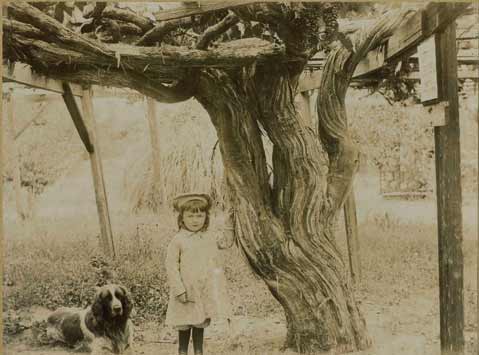‘With July 4th just past, I was wondering how Santa Barbara celebrated the centennial in 1876.’
- George Gregg

Before 1876, July 4th was not all that big a deal in Santa Barbara. The holiday was observed, but with nothing like the enthusiasm with which it is celebrated today. California had been a state for fewer than 30 years and many citizens looked more fondly back to the town’s Spanish and Mexican roots. In fact, it had been only a few years since English had replaced Spanish as the official language of local government. As the centennial approached, however, Santa Barbara geared up to celebrate in style.
All the states had been asked to take part in the Centennial Exposition held in Philadelphia. The Santa Barbara representative to California’s delegation, Dr. James L. Ord, had an idea. As Santa Barbara’s contribution to the California exhibit, why not send the famous Parra Grande, Montecito’s enormous grapevine? It could serve as the symbol of the South Coast’s agricultural richness.
Members of the Dominguez family had planted this huge grapevine sometime in the 1780s. By the mid 1870s, the trunk of the vine measured more than 40 inches in circumference and its branches spread out over 5,000 square feet. At its most prolific, it yielded around 20,000 pounds of grapes annually. It truly was a wonder of nature, matched only by an even larger grapevine growing in the Carpinteria Valley.
Ord convinced the vine’s owner, Michael Sarver, to ship it to Philadelphia. Sarver was reluctant, but it was obvious that the vine was dying anyway. Sarver decided to cut the vine into sections for transport eastward, and then reassemble it at the exposition. The journey was not an inexpensive proposition and a fundraiser was held in September 1875 to help defray costs.
After a difficult journey, the vine was set up in the California Hall in July 1876 and by all accounts it created a tremendous sensation. Easterners had never seen anything like it. The entire affair, however, proved too much for Sarver. He returned to his native Ohio in shattered health, where he died in early 1877. As for La Parra Grande, its ultimate fate remains unknown.
Back in Santa Barbara, plans went forward for the celebration. The centerpiece was a parade on State Street. One float carried the Goddess of Liberty surrounded by 38 young girls, representing the 38 states. There were a number of brass bands and gaily decorated wagons contributed by various area businesses.
After the parade, much of the crowd proceeded to a poultry farm near the Santa Barbara Mission. Here numerous toasts and speeches were made including an especially eloquent one in Spanish by a member of the De la Guerra family. One woman, who did not speak Spanish, was nevertheless captivated by the speaker’s “graceful and stirring delivery.” After the speechmaking, musicians played for dancing that went on into the late afternoon on a makeshift wooden floor that had been set up.
And what would July 4th be without fireworks? A number of young men had written Mayor Mortimer Cook petitioning him to set aside a special area for the use of firecrackers and other pyrotechnic devices. The mayor arranged for a vacant lot near the Arlington Hotel to be used, making sure it was cleared of all brush to guard against fire.
So ended the glorious Fourth of July of 1876. The South Coast had truly celebrated in style and had also made its mark on the national scene with the exhibit of the fabulous Parra Grande at the great Centennial Exhibition.



